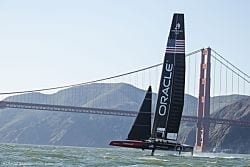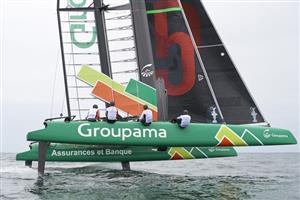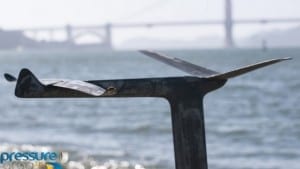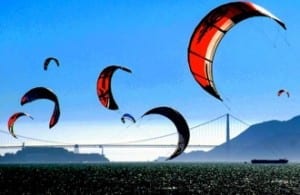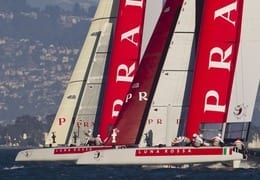
Luna Rosso AC45 on SF Bay during the 2013 America’s Cup World Series – lunarossachallenge.com
Luna Rossa, the Italian Challenger of Record, pulled out of the 2017 America’s Cup competition accusing the committee of illegitimate dealings regarding the class rule change from a 62 ft. to a 48 ft. wing-sailed catamaran. According to a statement signed by Britain (Ben Ainslie/BAR), France (Franck Cammas/Team France), Sweden (Iain Percy/Artemis Racing) and the US (Jimmy Spithill/Oracle Team USA), the majority voters said that all teams will have to make sacrifices due to this class change for the good of the America’s Cup. Luna Rossa, it is believed, was in an advanced stage of design and boat development for the AC62. Upon the announcement of their America’s Cup withdrawal, The World Series event previously scheduled for June in Cagliari, Italy, has now been cancelled.
Team New Zealand backed Luna Rossa in the voting and was angry with the committee for removing Auckland, NZ as the venue for the America’s Cup Qualifiers races. Though it may have been one more effort to reduce costs for the participating teams, America’s Cup Commercial Commissioner Harvey Schiller said the biggest reason for pulling the event from Auckland was Team NZ vacillating back and forth on their support for changing the class of boats from the AC 62 to the new 48 ft. America’s Cup Class. They are currently questioning the contractual obligations with the ACEA (America’s Cup Event Authority). Government funding would have been more readily available to Emirates Team New Zealand with Auckland as the venue for the Qualifiers event. AC Qualifiers regattas and playoffs will now be set in Bermuda, prior to the 2017 America’s Cup match.
More about the Rule and Protocol changes.
The America’s Cup Class Rule could only be changed by a unanimous vote, in the past. Recently, Protocol was amended with the lead from Oracle to change voting from unanimous to majority rule. The competitor committee of participants – Britain, France, Italy, New Zealand, Sweden and the US – all agreed to the change in Protocol. “During discussions last month, ALL six teams, including Team New Zealand, agreed on the need to change to a smaller boat to reduce costs. While Luna Rossa supported a less dramatic change, a majority of teams agreed on what has become the America’s Cup Class, a new rule written in consultation with ALL teams, with drafts of the rule sent to ALL teams for comment and feedback.”
In June 2014 the competitors group had unanimously voted on the length of the AC boat to be 62 ft. Then last month the teams agreed by a majority vote to change to the 48 ft. wing-sailed catamaran, significantly smaller than the AC72 used in the 2013 America’s Cup races. In hopes of more participation, this change, according to the teams, would significantly lower the costs of building, transporting and maintaining boats for many teams.
This is the first time in history that the design was changed midstream (Though there was the dumping midstream of the AC90s in 2008, that many forget.) and the first time in history that such a small 48’ boat is raced in the AC series, according to The Royal Gazette (Bermuda’s Daily Newspaper) Apr. 11, 2015.
However, these are foiling boats, flying machines. With foiling, the waterline length of the boat does not determine its speed as it does with non-foiling boats. This was proven when Oracle Team USA and Swiss Team Artemis Racing launched new foiling AC45s in Feb. of 2015 – reaching speeds in the 45-knot range. Watch the video.
Will other countries join the competition at this point? Can they? Will New Zealand stay in? Can they?
Meanwhile, the Luna Rossa AC72, on which the team reached the finals of the 2013 challenger selection series in the 34th America’s Cup, is now on display at the Aero-Naval Pavilion of the Museum of Science and Technology in Milan until 2017. More about Luna Rossa Challenge.
More about why now is the best time for the America’s Cup change
More about how the 65’ to 48’ change came about
